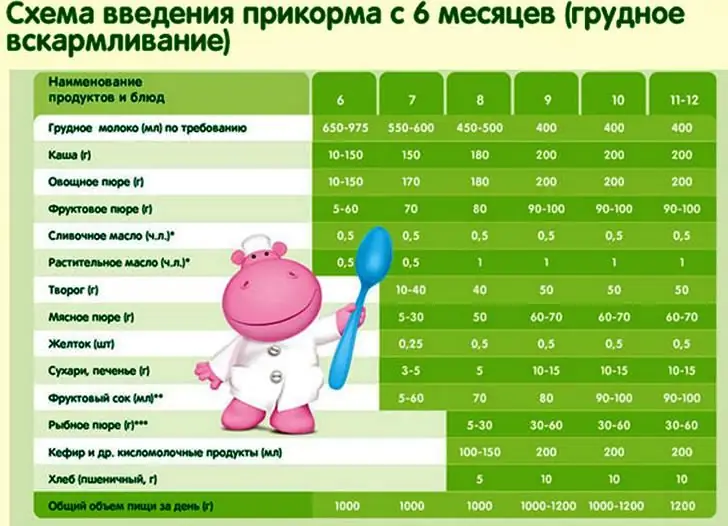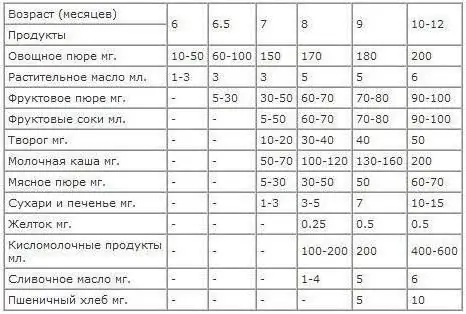2025 Author: Priscilla Miln | [email protected]. Last modified: 2025-01-22 17:55:24
Becoming parents, mom and dad are worried about when to start complementary foods. And it is no coincidence that they are concerned about this topic, because you should approach the nutrition of the baby responsibly. The he alth of the child, his taste preferences will depend on this. What advice should a young mother listen to so as not to harm her little one? Grandmothers advise one thing, doctors - another, girlfriends - a third. Where is the truth? When to start complementary foods?
In the days of our grandmothers, complementary foods were significantly different from today. So there is no need to listen to them. Calmly listen to their advice and lectures, but do your own thing.

When to start the first weaning? A he althy and normally gaining weight baby, without allergies and other diseases, begins to receive adult food at the age of 6 months. First of all, the baby needs to be introduced to vegetables, and only then to fruits. This should be done because fruits have a more pleasant and sweet taste, and in the future the child may refuse he althy vegetables.
So, what time to start giving complementary foods to a child, we have already found out. At 6 months we try to give the followingproducts: vegetable puree from potatoes, zucchini, cauliflower, carrots. With the latter, you should be careful, as it can cause allergies. And in general, be careful with brightly colored products, it is better to choose white or green ones for the first feeding. You can try to give broccoli, which is also extremely useful. It will be ideal if the vegetables are cooked in a double boiler and then mashed with a blender.

We will answer the question “what time to start complementary foods for a child” - at 6 months. Until this time, the baby receives the necessary substances and trace elements from breast milk or formula. You need to give the first products to the little one in microdoses and a little bit. On the first day, you can give 1 teaspoon of puree, on the second - a little more, in 10-20 days bring the serving volume to 120-125 g. Remember that the baby does not need s alt and sugar for up to a year, you should not overload the child's internal organs with them. Following the vegetables, you can also try fruits, this must be done in the same way. Choose green rather than red apples to avoid allergic reactions.
When should I start giving meat to my baby? From 7 months, you can try to give your child rabbit or veal meat. It will be perfectly combined and digested with vegetables. Remember that food must be ground in a blender. At the same age, you can try to introduce porridge into the baby's diet. It is better to start with gluten-free - buckwheat, corn, rice, oatmeal. They will go well with fruit if you add them to the porridge. Egg yolk can also be given at 7months. ¼ of the boiled yolk should be added to the vegetable puree. Start complementary foods from the yolk with a small dose the size of a match head.
Fruit juices can also diversify the baby's menu. At 8 months, it's time to eat fermented milk products, such as cottage cheese or natural yogurt. You can give a nibble on a baby cookie or a piece of an apple, if you have a few teeth.

When should I start feeding my baby fish? From 9 months you can feed your baby fish puree. Be careful when cleaning, remove all the bones, if necessary, you can scroll it through a meat grinder, then chop with a blender.
Remember that the age when you start complementary foods should not be earlier than 6 months! The baby's he alth depends on it.
Recommended:
Baby refuses complementary foods: basic rules for the introduction of complementary foods, first products, tips and tricks

Until one year of age, breast milk is the main source of nutrition. It is quite possible that at first the child will not perceive ordinary food and will refuse it in every possible way. Mom should learn about the basic rules for the introduction of complementary foods. And most importantly - to study the psychological aspects of the first complementary foods
Complementary foods are The concept, definition of what foods to start with and the timing of the introduction for the baby

Sooner or later, young parents are faced with the question of when and how to start introducing complementary foods into the baby's diet. As the child grows and develops, he becomes more and more active, and breast milk gradually loses the ability to fully replenish the supply of vitamins, minerals and trace elements necessary for a growing body
Complementary foods for babies: timing, types of complementary foods, necessary products

Baby's body is developing. He actively moves, sits down, tries to stand up. Weight gain starts to drop. This is one of the signals that it is time to introduce complementary foods. When and how best to do it?
WHO Complementary Feeding Scheme. Complementary foods: table by month. Children food

Children's body requires extremely careful observation in the first years of life. A huge role for the baby at this time is played by complementary foods. Every mother should know how to properly enrich the diet of her child so as not to harm him. Further attention will be offered to the complementary feeding scheme according to WHO
Complementary foods while breastfeeding. Complementary foods by months - table

With all the advantages of breast milk and its benefits for a growing body, there is still a drawback - the lack of vegetable protein and fiber in its composition, necessary for the full growth and physical development of the child. In this regard, it becomes necessary to introduce complementary foods during breastfeeding when the baby reaches a certain age

